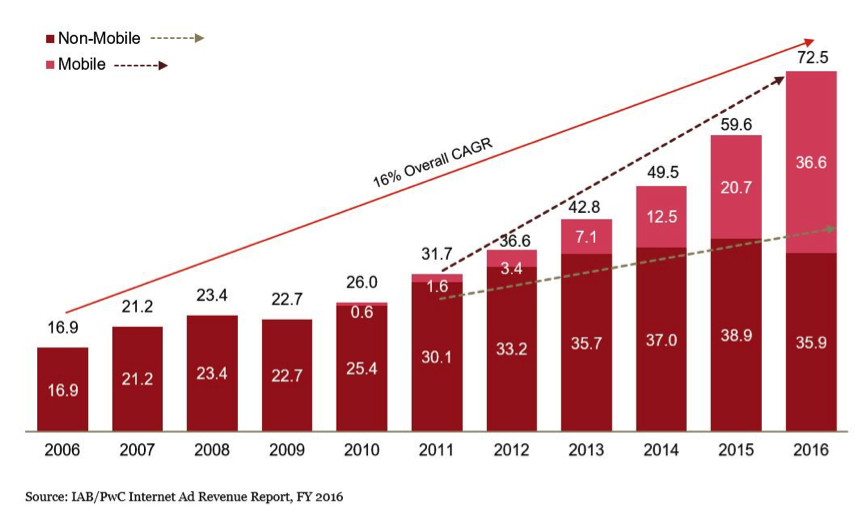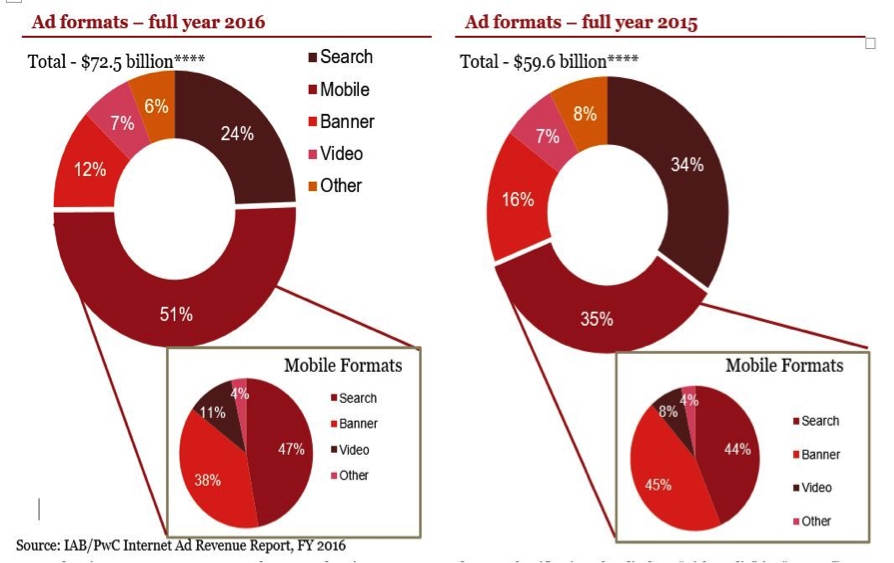By adaptive - June 5th, 2017
Mobile now dominates internet ad revenue, but is it the best bet? Susan Kuchinskas reports.
For the first time, mobile ad revenue made up more than half of all internet ad revenue; 2016 was the year of the big shift, according to the IAB. Is that because it’s so effective, or simply because that’s where the eyeballs are?
The IAB’s latest Internet Advertising Revenue Report, covering all of 2016, found overall revenue growth of 21.8 percent year-over-year. That overall revenue growth was fueled by mobile, the IAB said.

Among mobile ad formats, search increased its share from 44 percent in 2015 to 47 percent in 2016, biting into the share of banner ads. Even bandwidth-hogging mobile video advertising came close to equaling desktop video, at 85 percent of desktop video revenue.
Video everywhere
Video is a top driver of ad revenue growth across the board, and mobile is closing the gap. In 2016, mobile video revenue was 85 percent of desktop video revenue.
Increasingly, that video is consumed via social channels. In a survey of 300 agencies and marketers, Trusted Media Brands (TMB) found that social platforms were the top video distribution platforms. Social distribution got the highest marks for delivering on engagement, ROI and customer, although video platforms like YouTube scored higher on measurement and reporting.
“Buyers are looking at desktop and mobile as similar, although they’re not exactly the same,” says Rich Sutton, TMB’s chief revenue officer.
TMB, formerly The Reader’s Digest Association, is a multiplatform media company whose brands include Reader’s Digest, Family Handyman, Farm & Ranch Living, the Taste Community and Haven Home. The TMB study found that agencies have allocated approximately 29 percent of budgets to video, up 3 percent year over year; while marketers are allocating 26 percent, up 2 percent.
While some video ad campaigns on its network are mobile-only, Sutton says that most buyers do not differentiate.
That said, mobile and desktop are not exactly on par, he thinks. While mobile video provides almost the same reporting and measurement capabilities, Sutton says, “Measuring viewability on mobile is still not quite there. Yes, there are services out there that do it, but it’s trickier, because you’ve got two major operating systems and hundreds of versions of phone operating systems.”
Social is the place
Social media is driving the growth of mobile, the IAB said, because it’s such a significant activity on mobiles.
“If the idea is to go where the people are, they’re in social media, and clearly, in social media on their mobile devices,” says Maribel Lopez, principal and founder of Lopez Research. With social media, “You have a person in their personalized portal engaging with other people. You have the opportunity to figure out what they’re talking about and participate in a dialog with them. This is the power of bringing social and mobile together.”
Nevertheless, advertisers have difficulty assessing their ROI on social ads, according to Lopez.
“Social is where the eyeballs are,” Sutton says. A recent custom campaign for Hungry Jack on TasteofHome.com included video, an interactive hub and social integration. How-to videos highlighted breakfast ideas, and users could click through for recipes.
The outstanding average video completion and engagement rates illustrate the payoff from targeting the right people with quality content.
What is mobile?
In the summary of the IAB’s report was an intriguing quote from CEO Randall Rothenberg: “Mobile fueled the internet economy in 2016, with advertisers showing their confidence in digital to achieve their marketing goals. This increasing commitment is a reflection of brands’ ongoing marketing shift from ‘mobile-first’ to ‘mobile-only’ in order to keep pace with today’s on-the-go consumers.”
Anna Bager, senior vice president and general manager of the IAB’s mobile and video initiatives, noted, “In 2020, the world is going to be predominantly mobile--if not mobile only. It’s important to remember that the mobile phone is the not the only mobile platform on which we can consume media, and devices will evolve to move with consumers throughout the day. Advertisers, agencies, and publishers need to keep a sharp eye on this shift to stay in step with the end-user and advances in technology."
The line between PC and mobile already has blurred, according to Lopez. “The whole distinction between mobile and other devices is crap,” she says. PC-style devices are increasingly mobile, while the difference in screen real estate between a small notebook, a tablet and a large-screen phone has shrunk. At the same time, operating systems have become similar in capabilities.
That said, she doesn’t see multi-channel advertising going away. For one thing, there can be a difference in the quality of attention when someone’s mobile—more in the moment and less considered.
Says Lopez, “If you’re a retailer and you can reach someone online with a better screen and easier access to information, it

